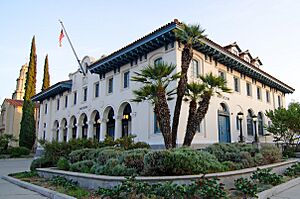Museum of Riverside facts for kids

Built 1912–1914 as the United States Post Office and Federal Building
|
|
| Former name | Riverside Metropolitan Museum |
|---|---|
| Established | 1924 |
| Location | Riverside, California |
| Type | History, Indigenous resources, Natural History |
| Collection size | 200,000 |
| Official name: Riverside Municipal Museum | |
| Reference #: | 11 |
The Museum of Riverside is a cool place in Riverside, California. It teaches you about the history of the area, the culture of Native American people, and nature. You can find it in the historic Mission Inn District. The museum used to be called the Riverside Metropolitan Museum or Riverside Municipal Museum. It is part of the City of Riverside. However, two groups, the Riverside Museum Associates (RMA) and the Harada House Foundation (HHF), also help support it. The museum's goal is to learn about, save, explore, and share the history of Riverside and its region.
Contents
Museum History
The Museum of Riverside started on December 12, 1924. This happened when the wife of Cornelius Earle Rumsey gave his collection of Native American items to the City of Riverside. Mr. Rumsey used to work for the National Biscuit Company (Nabisco). He moved to Riverside for his health. There, he became very interested in items made by Native American people.
Museum Locations Over Time
The museum was first in the basement of the old City Hall building. It stayed there from 1925 to 1948. Then, it moved to the basement of its current building. This building was originally a Federal Post Office. For many years, the museum shared its space with the city's police department. It also shared with the U.S.D.A. During World War II, the Fourth Air Force used some of the building too. As the museum's collections grew, it took over all the floors. This expansion happened in the 1960s and 1970s. In 1978, the museum's downtown Riverside building was added to the National Register of Historic Places. This means it is a very important historical site.
Amazing Collections
Over time, the museum's collections grew very large. There are about 200,000 items and specimens. These include 2,500 feet of old documents. They cover history, natural history, and Native American culture. These items show how Riverside and the areas around it grew. They go from before people settled there until today.
Some special collections include:
- A great collection of Native American baskets.
- Old documents about two important Riverside landmarks. These are the Mission Inn and Harada House.
- The Clark Herbarium, which has many pressed plant samples.
- Items and tools from Riverside's citrus industry. This industry was big in the 1800s and 1900s.
- Archaeological finds from Riverside's Chinatown.
The museum also has strong collections in geology, insects, and textiles (fabrics).
Special Historic Homes
The museum also takes care of two historic homes. One is the Heritage House. The other is the National Historic Landmark Harada House.
Heritage House
Heritage House is a beautiful home built in 1891. It is in the Queen Anne style. Since 1977, it has been a museum itself. It shows what life was like in Riverside in the 1890s. This was when the citrus industry was at its peak.
Harada House
Harada House is a very important place for civil rights in California. The story of the Harada family and their home shows big ideas. These include civil rights, individual rights, democracy, and immigration. It also teaches about becoming a citizen and diversity.
Important People at the Museum
After he stopped teaching at Riverside Junior College, a famous naturalist named Edmund C. Jaeger worked at the museum. He greatly improved the plant collections. A well-known anthropologist, Christopher Moser, also worked there for many years until 2003.
The Museum of Riverside was one of the first museums in the country to be approved by the American Alliance of Museums (AAM). This means it meets high standards.
Building Design
The museum building was designed in the Neo-Classical style. This style was popular in Southern California. It also has details from the Mission Revival style. The roof has ceramic tiles, which makes it look like Spanish-style buildings.

